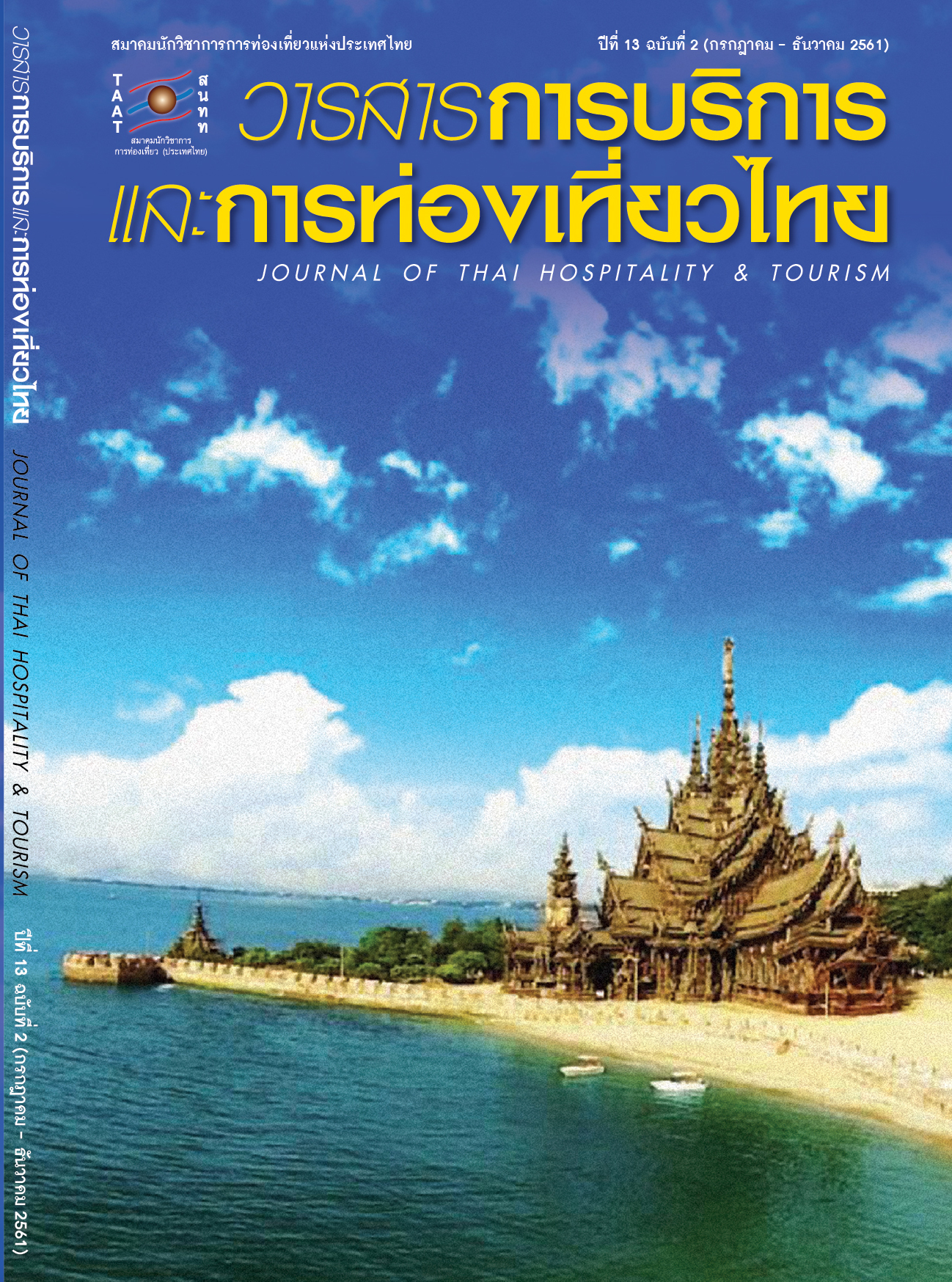The Influence of Incentive Travel that Impact on Purchase Intention with an Insurance Company in Thailand
Main Article Content
Abstract
This study aims 1. To study the important perception factors of incentive travel with insurance company. 2. To study incentive travel factors that influence on purchase intention with insurance company. This quantitative study was initially started by conducting the literature reviews for formulating the questionnaire as a data collection tool. The questionnaire consists of four parts include personal information, incentive travel factors, purchase intention and suggestion. It has 40 items measured by 5-point Likert scale ranked from 1 (least important) to 5 (most important). The respondents of this study were life insurance agents in Bangkok, Thailand. Sampling technique was used probability sampling, the sampling method using Taro Yamane (1967). Totally collected 400 respondents who have insurance-license only. The data will analyzed by descriptive statistics including frequency, percentage, mean and standard deviation (SD); and multiple regression. As a result, show the important perception factors of incentive travel with insurance company including eight factors as attraction, facility, accessibility, destination image, price, safety, service and promotion. There are only four factors that can be used to predict purchase intention with insurance company as Y = .980 +.155 X8** + .235 X4** + .171 X1** + .140 X7*; X8 = Promotion; X4 = Destination Image; X1 = Attractions; X7 = Service; that impact on dependent variable 29.4%. The highest ranked score is promotion, destination image, attractions and service, respectively.
Article Details
References
[2] Arslan, R. Z. (2014). Impact of Brand Image and Service Quality on Consumer Purchase Intention: A Study of Retail Store in Pakistan. Research on Humanities and Social Sciences, 4(22), 98-105.
[3] Boulding, K. E. (1956). The Image: Knowledge and Life in Society. Ann Arbor MI: University of Michigan Press.
[4] Cooper, C., & Hall, M. (2008). Contemporary Tourism: An International Approach. London: Butterworth-Heinemann.
[5] Endah, P. E., Umar, N., Suharyono, S., & Andriani, K. (2017). The Antecedents of Behavioral Intention Regarding Rural Tourism Destination. Asia Pacific Journal of Tourism Research, 22(11), 1169-1181.
[6] Ferreira, S.D., Rial, A., & Varela, J. (2009). Post Hoc Tourist Segmentation with Conjoint and Cluster Analysis. Journal of Tourism and Cultural Heritage, 7(3), 491-501.
[7] Hopkins, L., & Ferguson, K. E. (2014). Looking Forward: The Role of Multiple Regression in Family Business. Journal of Family Business Strategy, 5, 52-62.
[8] Hung-Tai Tsou, Feng-Hsu Liu, Hsuan-Yu Hsu. (2015). Selecting Business Partner for Service Delivery Co-Innovation and Competitive Advantage. Management Decision, 53(9), 2107-2134.
[9] Gines, K. (2008). The Incentive Travel Buyer’s Handbook. 6th ed. New York: Nielsen Business Media.
[10] Incentive Research Foundation. (2016). Trend in Incentive Travel, Reward, and Recognition. Retrieved from https://theirf.org/research/irf-2016-trends-in-incentive-travel-rewards-and recognition/1692/.
[11] Jang, C., & Topal, E. (2013). Optimizing Overbreak Prediction Based On Geological Parameters Comparing Multiple Regression Analysis and Artificial Neural Network. Tunnelling and Underground Space Technology, 38, 161-169.
[12] Jeffrey, S. A. (2014). The Motivational Power of Incentive Travel: the Participant’s Perspective. Journal of Behavioral and Applied Management, 15(3), 122-139.
[13] Kay, H. K. (2003). Selling Tourism. New York: Delmar Learning.
[14] Koc, E. (2004). The Role of Family Members in the Family Holiday Purchase Decision-Making Process. International Journal of Hospitality & Tourism Administration, 5(2):85-101.
[15] Lawson, F., & Baud-Bovy, M. (1977). Tourism and Recreational Development. London: Architectural Press.
[16] Maslow, A. (1970). Activation and Personality. 2nd ed. New York: Harper & Row.
[17] Nikhashemi, S. R., Haque, A., Yasmin, F., & Khatibi, A. (2012). Service Quality and Customer Purchase Intention in Online Shopping: An Empirical Study in Iran. International ISI Conference on Economic and Business Innovation, 38, 150-54.
[18] Ninemeier, J. D., & Perdue, J. (2005). Hospitality Operations: Careers in the World's Greatest Industry. New Jersey: Pearson Prentice-Hall.
[19] Ninemeier, J. D., & Perdue, J. (2008). Discovering Hospitality and Tourism: the World's Greatest Industry. 2nd ed. New Jersey: Pearson Prentice-Hall.
[20] Pratt, M. A. (2014). Predicting Wine Tourism Intention: Destination Image and Self-Congruity. Journal of Travel & Tourism Marketing, 31(4), 443-460.
[21] Rajesh, R. (2013). Impact of Tourist Perceptions, Destination Image and Tourist Satisfaction on Destination Loyalty: A Conceptual Model. Journal of Tourism and Cultural Heritage, 11(3), 67-78.
[22] Svetlana, S., & Juline, E. M. (2010). Destination Image: A Meta-Analysis of 2000-2007 Research. Journal of Hospitality Marketing & Management, 19(6), 575-609.
[23] Swarbrooke, J., & Horner, S. (2005). Consumer Behavior in Tourism. Amsterdum: Elsevier.
[24] Thai Life Assurance Association (2016). Annual Report 2016. Retireved from https://tu.listedcompany. com/misc/ar/20170314-tu-ar2016-en-02.pdf
[25] UNWTO. (2017). UNWTO Annual Report 2016. Retrieved from https://cf.cdn.unwto.org/sites/all/files/pdf/annual_report_2016_web_0.pdf
[26] Yamane, T. (1967). Statistic: An Introductory Analysis. New York: Harper & Row.


